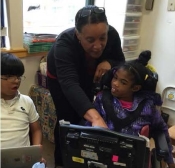
_ by PRC_
Stephanie Taymuree has witnessed huge advances in augmentative and alternative communication (AAC) during her nearly 40 years as a speech-language pathologist (SLP) and special educator, and her implementation of AAC technology in the classroom is unrivaled. But she still finds it thrilling when a student embraces AAC to express a novel thought or idea.
“My very best days are those when an AAC user calls my name and is then able to successfully communicate a message to me about something of which I have no previous knowledge or context,” she says. “The happiness and laughter that ensues with those connections is my absolute reward!”
Taymuree teaches 3rd-5th graders at Redwood Heights Elementary School in Oakland, CA. Her students have cerebral palsy, severe verbal apraxia, traumatic brain injury, ASD, and various syndromes that affect speech and language development.
“Our Technology & Augmentative Communication for Learning Enhancement (T.A.C.L.E.) program is a special day class program for students with complex communication needs,” she says of the program she was selected to launch in the early 1990s. “My students require multimodal communication strategies, including the use of high-tech speech-generating devices (SGDs), to communicate within their environment and access the academic curriculum.”
Taymuree works diligently with other school staff members to support her students’ success in school. “Some of the students in my program are included in general education classes for academic subjects. Those students generally need modifications to the way curriculum is represented, the way they can express their knowledge, and options of engagement.”
Modifying the curriculum presentation for special needs students could include “using enlarged text, having textbooks and grade-level literature read aloud with text highlighting, symbolated text for students who continue to need graphic support, teacher-created Smart Board lessons, or teacher-created Classroom Suite lessons to enhance a concept being taught,” she says.
To enable a student to express their knowledge, Taymuree might recommend interfacing a student’s SGD with a computer for writing activities, programming specific “fringe vocabulary” into the device for classroom “academic talk,” or teaching several non-disabled classmates to facilitate a student’s engagement in cooperative learning tasks. Modification of options to engagement could include programming a “script” into a voice-output communication aid or SGD for participation in a skit, game, or shared reading.
Such modifications are essential to successful inclusion, she says, “and require the collaborative effort and planning of the special education teacher, general education teacher, and supporting paraprofessionals. One afternoon each week, we meet to discuss the need for upcoming modifications/adaptations, device programming, accessibility and transportation planning for field trips, social-emotional learning, and friendships, etc.”
There are no comments yet. Be the first to post!You must be logged in to post.
Stories and Strategies fo...















